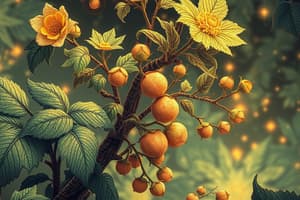Podcast
Questions and Answers
What do we call organisms that cannot make their own food?
What do we call organisms that cannot make their own food?
Heterotrophs
What is the mode of nutrition in which organisms make food themselves?
What is the mode of nutrition in which organisms make food themselves?
- Dependent nutrition
- Autotrophic nutrition (correct)
- Synthesis nutrition
- Heterotrophic nutrition
Where are the food factories of plants located?
Where are the food factories of plants located?
Leaves
Plants can prepare food using carbon dioxide, water, and sunlight.
Plants can prepare food using carbon dioxide, water, and sunlight.
What green pigment helps leaves capture sunlight?
What green pigment helps leaves capture sunlight?
What is the process called where plants synthesize food?
What is the process called where plants synthesize food?
How do plants obtain water and minerals?
How do plants obtain water and minerals?
What is the role of guard cells?
What is the role of guard cells?
The _____ in the leaves allows for gas exchange.
The _____ in the leaves allows for gas exchange.
Match the following terms with their descriptions:
Match the following terms with their descriptions:
Match the following nutritional modes with the corresponding plant examples:
Match the following nutritional modes with the corresponding plant examples:
Match the following types of plants with their characteristics:
Match the following types of plants with their characteristics:
Match the following processes with their roles in plant nutrition:
Match the following processes with their roles in plant nutrition:
Match the following nutrients with their sources in plants:
Match the following nutrients with their sources in plants:
Match the plant components with their functions:
Match the plant components with their functions:
Match the types of leaves with their pigment characteristics:
Match the types of leaves with their pigment characteristics:
Match the test performed with its purpose:
Match the test performed with its purpose:
Match the sources of nutrients to their types:
Match the sources of nutrients to their types:
Match the condition of the plants with their observed outcomes:
Match the condition of the plants with their observed outcomes:
Flashcards are hidden until you start studying
Study Notes
Nutrition in Plants
- Food is essential for all living organisms, consisting of carbohydrates, proteins, fats, vitamins, and minerals known as nutrients.
- Nutrition enables organisms to build bodies, grow, repair damaged parts, and provide energy for life processes.
- Plants are autotrophs, meaning they synthesize their own food from simple substances such as water, carbon dioxide, and minerals.
- Animals, including humans, are heterotrophs; they obtain food from plants or animals that consume plants.
Mode of Nutrition in Plants
- Only plants can produce food independently, while animals must rely on plants or other animals for sustenance.
- Questions arise regarding the location and nature of food production in plants, including how they gather and transport raw materials.
Photosynthesis - Food Making Process
- Leaves function as the food factories of plants, where food synthesis occurs.
- Water and minerals from the soil are absorbed by roots and transported to leaves, while carbon dioxide enters through stomata.
- Stomata are tiny pores in leaves, regulated by guard cells, crucial for gas exchange.
Role of Chlorophyll
- Chlorophyll, a green pigment in leaves, captures sunlight, which is vital for photosynthesis.
- Photosynthesis is defined as the process of converting light energy into chemical energy by combining sunlight, water, and carbon dioxide.
- This unique process allows plants to store solar energy and create their own food.
Transport in Plants
- Vascular systems in plants, functioning like pipes, transport water and nutrients from roots through the stem to leaves, ensuring continuous delivery of materials necessary for photosynthesis.
Photosynthesis and Starch Production
- Starch presence in leaves indicates photosynthesis, as starch is a carbohydrate produced during this process.
- Guard cells surround stomata, which are tiny pores that control gas exchange in leaves.
- Leaves of various colors (deep red, violet, brown) can still perform photosynthesis despite lacking green chlorophyll.
Nitrogen in Plants
- Proteins contain nitrogen, which plants acquire from the soil through certain bacteria that convert gaseous nitrogen into a usable form.
- Nitrogen-rich fertilizers are often added by farmers to enhance soil nutrient content for plant health and growth.
Modes of Nutrition in Plants
- Some plants, like Cuscuta (Amarbel), lack chlorophyll and rely on a host plant to obtain nutrients, demonstrating a parasitic mode of nutrition.
- Algae, aquatic organisms, can photosynthesize while also displaying a green color due to chlorophyll presence.
Cell Structure in Organisms
- Cells are the basic units of life, enclosed by cell membranes, containing a nucleus and cytoplasm.
- Most cells will only be visible under a microscope due to their small size.
Stomata Functionality
- Stomata are crucial for gas exchange, allowing carbon dioxide to enter, facilitated by guard cells.
- Photosynthesis occurs in the presence of sunlight, utilizing chlorophyll, carbon dioxide, and water to produce food.
Fungus and Nutrition
- Fungi exhibit saprotrophic nutrition by absorbing nutrients from decaying matter, such as bread and pickles.
- Fungi do not have chlorophyll and, hence, cannot photosynthesize like green plants.
Nutrient Replenishment in Soil
- Farmers apply manure and fertilizers to replenish depleted soil nutrients, essential for healthy plant growth.
- Nutrients like nitrogen, potassium, and phosphorous are commonly included in fertilizers to restore soil fertility.
Fungi and Spoilage
- Fungi can cause diseases in plants and animals, including humans, but some fungi are beneficial and used for medicinal purposes.
- Fungal spores are present in the air, especially during humid conditions, leading to rapid growth on moist food items.
Studying That Suits You
Use AI to generate personalized quizzes and flashcards to suit your learning preferences.




